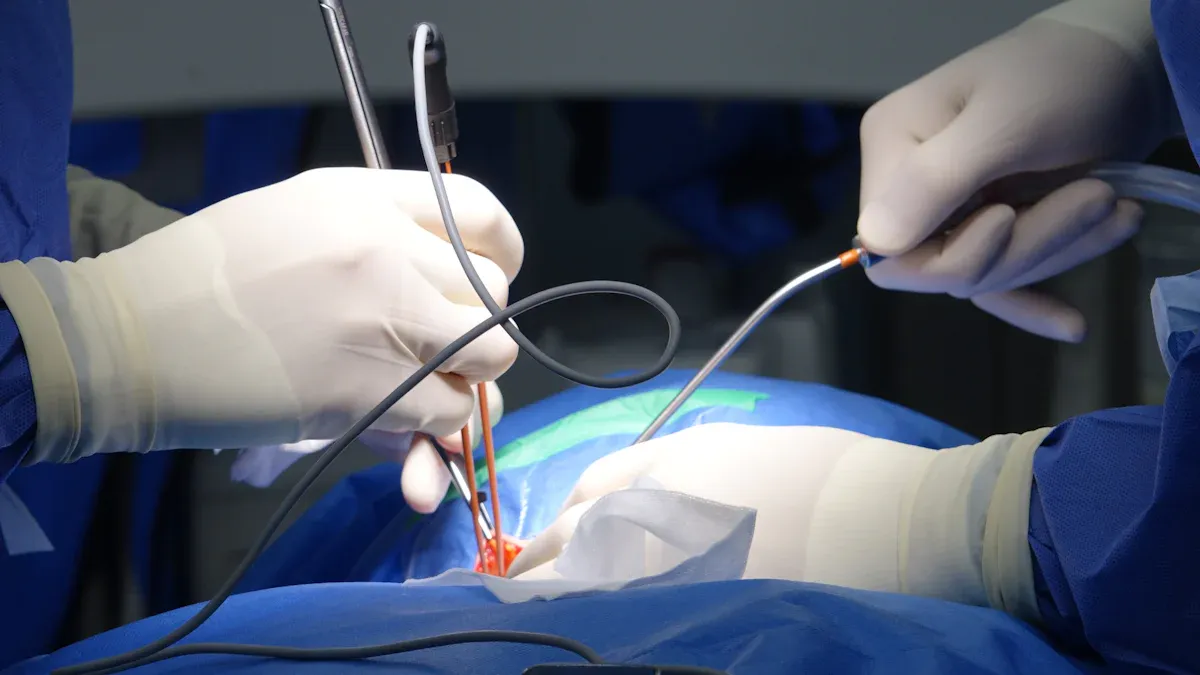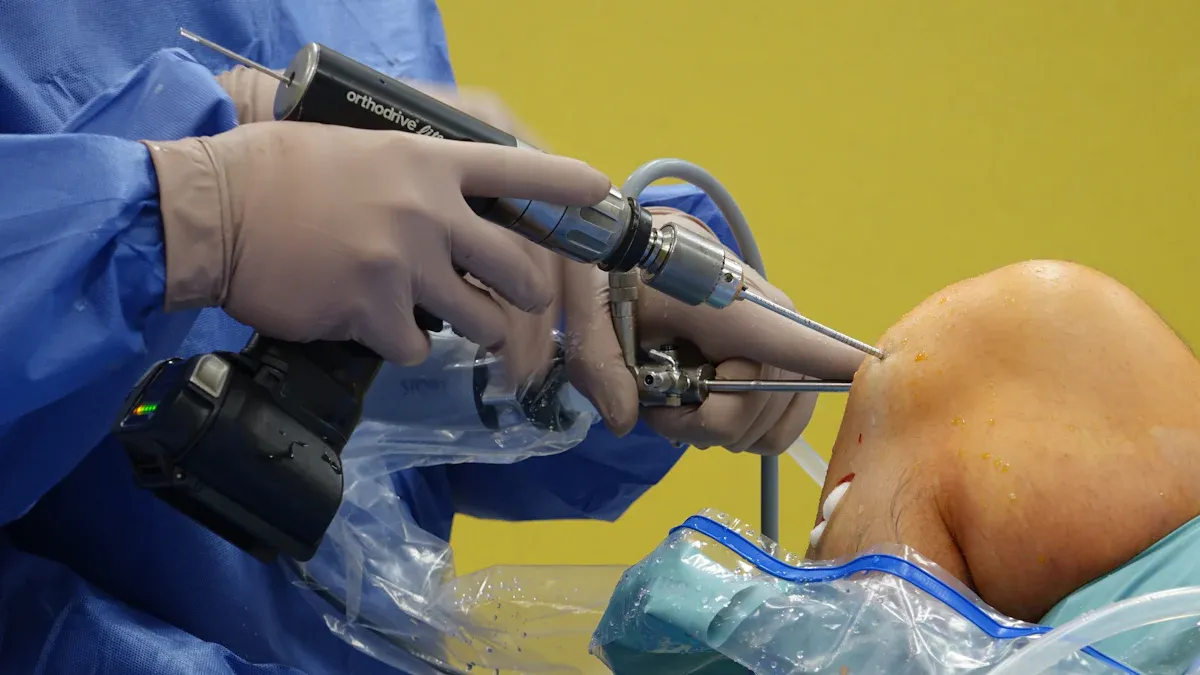How Nitinol Tubing is Revolutionizing Minimally Invasive Surgery

Nitinol catheter tubing is revolutionizing the way minimally invasive surgeries are performed. Its ability to bend into complex shapes and return to its original form allows doctors to execute precise procedures with ease. This flexibility is particularly beneficial for surgeons working in delicate areas, making minimally invasive surgery more effective and accessible. Additionally, Nitinol catheter tubing is biocompatible, reducing the risk of complications and ensuring patient safety.
The demand for minimally invasive surgery Nitinol catheter tubing is rapidly increasing. Industry experts forecast its market value to rise from $1.2 billion in 2024 to $2.5 billion by 2033, with an annual growth rate of 9.5% starting in 2026. These projections highlight the significant impact Nitinol catheter tubing is having on advancing healthcare solutions.
Key Takeaways
Nitinol tubing can bend and return to its shape. This makes it perfect for accurate surgical tools.
Nitinol tubing is safe for the body, lowering surgery risks. It helps patients have safer surgeries.
Nitinol tubing is strong and lasts through repeated use. This makes it great for devices like stents that stay in the body.
Using nitinol tubing means smaller cuts during surgery. Patients heal faster and have less damage to their tissues.
New ideas with nitinol tubing allow custom surgical tools. These tools improve safety and make treatments work better.
Unique Properties of Nitinol Tubing

Shape Memory and Superelasticity
Nitinol tubing is special because of its shape memory and superelasticity. It can bend under pressure and return to its shape when the pressure stops. This makes it perfect for surgical tools that need to move through tricky body areas without staying bent.
Studies show nitinol tubing can handle a shape recovery strain of 4.16% and a superelastic strain of 7%. These numbers prove how accurate and dependable it is for medical use. For instance, nitinol stents can expand to fit blood vessels and shrink back when removed. This flexibility helps tools work well even in tough situations.
Tip: Nitinol tubing’s superelasticity and shape memory make it great for flexible tools like guidewires and robotic instruments.
Biocompatibility and Corrosion Resistance
Nitinol tubing is not only bendable but also safe for the body and resists rust. These features make it reliable for long-term use inside people. It passes strict tests like ISO 10993 to ensure it doesn’t harm the body or cause irritation.
Research shows nitinol implants rarely cause problems, even after 10 years. This safety is vital for devices like stents, which must stay strong and non-reactive in the body. Its rust resistance also keeps it working well in wet or acidic conditions inside the body.
Note: Nitinol tubing’s safety and rust resistance lower risks, making it a top choice for surgical tools.
Durability and Fatigue Resistance
Nitinol tubing is very strong and can handle repeated use without breaking. Tests show advanced nitinol alloys last longer than regular materials, with nearly double the fatigue strain limits.
For example, High-Purity VAR Nitinol has a fatigue strain limit of 0.32% for wire and 1.75% for diamonds. This strength comes from fewer weak spots in the alloy, which prevents cracks. In hospitals, nitinol tubing’s durability means tools like stents can last through millions of uses without failing.
Metric | Description |
|---|---|
Fatigue Life | Tracks strain and break chances over 10⁷ cycles. |
Tensile Strength | Measures the heaviest load the tubing can take. |
Residual Elongation | Checks strain differences during loading and unloading. |
Tip: Nitinol tubing’s strength and flexibility make it essential for reliable surgical tools used over time.
Applications in Minimally Invasive Surgical Tools

Stents and Vascular Implants
Nitinol tubing is important for making stents and vascular implants. Its shape memory lets stents expand and fit blood vessels perfectly. This helps keep blood flowing smoothly. Its superelasticity makes stents strong enough to handle daily movements like walking or climbing stairs. Stents near the heart can handle over 400 million cycles, making them dependable for long-term use.
The strength of nitinol tubing lowers the chance of breaking or wearing out, which is crucial for vascular implants. Studies like the ORION trial show how effective nitinol stents are. For example:
Trial Name | Device | Patient Enrollment | Major Adverse Events (MAE) | Duration |
|---|---|---|---|---|
ORION | EPIC™ Self-Expanding Nitinol Stent System | 123 patients at 25 sites | Evaluated at 9 months | 9 months |
These findings show that nitinol tubing helps stents last longer and work better, improving vascular health for patients.
Minimally Invasive Surgery Nitinol Catheter Tubing
Nitinol catheter tubing is changing surgeries by being flexible and precise. Its superelasticity lets catheters move through tricky body paths without losing their shape. Its biocompatibility makes it safer by lowering risks like blood clots or bad reactions.
Data proves its success. Nitinol catheters have a 92% delivery success rate with no major complications. This makes nitinol tubing essential for delicate surgeries, like those in the brain or blood vessels.
Tip: Nitinol tubing’s shape memory helps catheters adjust to hard-to-reach areas while staying reliable.
Guidewires and Robotic-Assisted Instruments
Guidewires and robotic tools work better with nitinol tubing. Its superelasticity helps guidewires move easily through tight or curved spaces. For example, the Silverway guidewire has a 98% success rate in crossing blood vessels, showing how accurate nitinol tools are.
Robotic instruments use nitinol tubing to perform complex surgeries more precisely. These systems reduce risks compared to manual methods.
Property | Description |
|---|---|
Superelasticity | Bends without breaking, making tools easier to use. |
Shape Memory | Returns to original shape, ensuring tools stay reliable. |
Biocompatibility | Reduces bad reactions, keeping patients safe. |
Durability | Resists wear and tear, lasting longer in medical devices. |
These features make nitinol tubing key for robotic surgical tools, ensuring they stay effective and safe over time.
Note: Nitinol tubing in robotic tools is helping create advanced surgical devices that focus on accuracy and patient care.
Advantages of Nitinol Tubing in Surgical Procedures
Allowing Smaller Cuts and Faster Healing
Nitinol tubing helps surgeons make smaller cuts during surgeries. Its bendable nature lets doctors move through tricky body areas without big openings. This causes less harm to tissues and speeds up healing. For example, nitinol catheters and guidewires can reach tough spots carefully, reducing damage to nearby tissues.
The retrievers device group is popular because it improves surgery efficiency. Its shape memory and superelasticity keep tools in shape under pressure, making movement smoother. This means patients spend less time in the hospital and recover faster.
Tip: Smaller cuts mean less scarring and fewer infections, making nitinol tubing a big improvement in modern surgeries.
Boosting Accuracy in Surgical Tools
Nitinol tubing makes surgical tools more precise and dependable. Its superelasticity lets tools bend and fit the body’s shape without breaking. This is very important for delicate surgeries, like those on blood vessels or the brain.
Studies show nitinol devices are highly accurate. For example:
Device Type | Success Rate | Notes |
|---|---|---|
Silverway guidewire | 98% | Easily crosses blood vessels |
Catheters | 92% | Works well in most cases |
Nitinol implants | 30% lower rejection rate | Better than older materials |
These results prove nitinol tubing reduces mistakes and makes surgeries more efficient. Its safety for the body also makes it a top choice for advanced tools.
Helping Patients Heal Better and Safer
Nitinol tubing helps patients by lowering risks from older methods. Its strength allows tools to be reused many times without breaking. Research shows it is safe for long-term use, with very few bad reactions.
The growing need for minimally invasive surgeries in heart and urinary care highlights nitinol tubing’s value. Its ability to resist kinks and bend easily gives surgeons confidence during tough procedures. For example, SMART stents treated 137 legs with a 98% success rate and 92% open blood flow after six months, proving nitinol’s reliability.
Note: By reducing rejection and improving accuracy, nitinol tubing helps patients heal faster and stay healthier longer.
The Future of Nitinol Tubing in Healthcare
Innovations in Minimally Invasive Surgical Tools
Nitinol tubing is helping create better surgical tools. These tools will be smaller and more accurate. They will also move easily through complex body areas. For example, new stents made with magnesium and nickel-titanium will be tested on people in 2025. These stents aim to fix problems with staying in the body too long, making them safer. Another example is flexible catheter springs, approved in 2024, which are already lowering tissue damage during brain surgeries.
Other exciting ideas include springs that release medicine directly to target areas. Animal tests show they may help treat cancer. Medtronic’s Symplicity Spyral system uses nitinol tubing to lower high blood pressure. These tools are making surgeries safer and improving results for patients.
Expanding Applications in Personalized Medicine
Nitinol tubing is also helping doctors create treatments just for you. AI is now designing stents that fit each patient perfectly. This reduces risks and makes surgeries safer. Tiny stents are another new idea. They can move through very small spaces, like in the brain. These changes make treatments more effective and safer for everyone.
New materials are making nitinol tubing even better. These materials last longer and work well inside the body. Eco-friendly ways to make nitinol tubing are also reducing harm to the environment. These improvements show how nitinol tubing is helping both healthcare and the planet.
Integration with Advanced Medical Technologies
Nitinol tubing is working with new medical technologies to improve care. For example, Abbott’s TriClip system, approved in 2024, uses nitinol to fix heart valves. Another example is the Synchron Stentrode implant, which reads signals from the brain. This device is opening new doors in brain technology.
Nitinol tubing is perfect for these uses because it is safe for the body. It bends easily, lasts a long time, and doesn’t rust. These features make it great for tools like stents, which have fewer problems after surgery.
As technology grows, nitinol tubing will be used in even more advanced tools. It works well with robots and imaging systems, keeping it at the front of medical innovation.
Nitinol tubing is changing surgery with its bendability, strength, and safety. It has special features like shape memory and superelasticity. These help tools adjust to hard procedures while keeping patients safe. For instance, stents for the brain and heart can handle many bends. This makes surgeries work better and helps patients heal faster.
As technology improves, nitinol tubing will be used more in new tools. These tools will be designed to fit each patient’s needs. Nitinol tubing will keep making healthcare safer and more effective in the future.
FAQ
Why is nitinol tubing good for brain surgeries?
Nitinol tubing bends easily and remembers its shape. This helps it move through tricky brain pathways. It also makes tools stay in the right spot, lowering surgery risks. These features make it great for delicate brain and blood vessel operations.
How does nitinol tubing help patients recover?
Nitinol tubing allows smaller cuts, which heal faster. It is safe for the body and lasts a long time. These qualities make surgeries more accurate and comfortable. Patients recover better with fewer problems.
Can nitinol tubing be made special for brain surgeries?
Yes, nitinol tubing can be adjusted for brain surgeries. Makers can change its size, bendability, and strength to fit the job. This helps tools work well in hard-to-reach areas, making surgeries safer and quicker.
Why is it important that nitinol tubing is safe for the body?
Being safe for the body means nitinol tubing doesn’t cause bad reactions. This is very important for brain surgeries, where tools must stay steady and not irritate tissues. Safety lowers risks like swelling and keeps patients comfortable.
What new ideas are coming for nitinol tubing?
Future changes include better designs for brain surgeries and smarter tools using AI. These updates will make surgeries safer and more accurate. Tools will fit patients better, helping them heal faster and with fewer risks.
See Also
The Importance of Nitinol Tubing in Minimally Invasive Surgery
Nitinol Tubing's Impact on the Future of Medical Devices
Nitinol Tubing's Contribution to Progress in Medical Technology
Nitinol Tubing's Significance in Cutting-Edge Medical Applications
The Manufacturing Process of Nitinol Tubing for Healthcare Use

